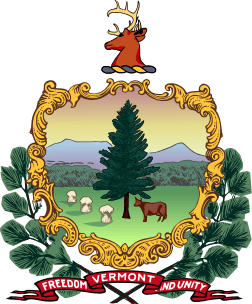Ezra Butler
Ezra Butler (September 24, 1763 – July 12, 1838) was an American clergyman, politician, lawyer, judge, the 11th Governor of Vermont, and a United States Representative from Vermont.
Ezra Butler | |
|---|---|
.jpg) | |
| 11th Governor of Vermont | |
| In office October 13, 1826 – October 10, 1828 | |
| Lieutenant | Aaron Leland Henry Olin |
| Preceded by | Cornelius P. Van Ness |
| Succeeded by | Samuel C. Crafts |
| Member of the U.S. House of Representatives from Vermont's at-large district | |
| In office March 4, 1813 – March 3, 1815 | |
| Preceded by | Seat added |
| Succeeded by | John Noyes |
| Member of the Vermont House of Representatives | |
| In office 1794–1797 1799–1804 1807 1808 | |
| Personal details | |
| Born | September 24, 1763 Lancaster, Province of Massachusetts Bay, British America |
| Died | July 12, 1838 (aged 74) Waterbury, Vermont, U.S. |
| Political party | Democratic-Republican National Republican Anti-Masonic |
| Spouse(s) | Tryphena Diggins |
| Profession | Lawyer, judge, politician |
Biography
Butler was born in Lancaster in the Province of Massachusetts Bay. In 1770 he moved with his parents to West Windsor, Vermont. His mother died while he was still a boy, and, after living with his elder brother for several years, he engaged in agricultural pursuits in Claremont, New Hampshire, until he was an adult. He served in the Continental Army for six months in 1779 during the American Revolution.[1][2]
Career
In 1775 Butler staked a claim, as the second settler in Waterbury, Vermont.[3] He returned in 1776 with his wife, Tryphena Diggins, with whom he eventually had eleven children.[4]
In 1785, Butler studied law in Waterbury, Vermont, and after he passed the bar, in 1786, he practiced law, and served as Town Clerk in 1790. In 1790, he began to think seriously on religious subjects, became a Baptist in 1791, and in 1800 began to preach at Bolton, Vermont. A Baptist church was organized in Waterbury in 1800, and he was its pastor for more than thirty years. He did not allow his ordination to the ministry to interfere with his public career.[2]
Butler was one of the first three selectmen of Waterbury. He was elected member of the Vermont House of Representatives, an office he held from 1794 to 1797; from 1799 to 1804; in 1807; and in 1808.[5] He was the first judge of the Chittenden County Court from 1803 to 1806; Chief Justice in Chittenden County from 1806 to 1811; and Chief Justice of Jefferson County from 1812 to 1825 (excepting periods of congressional service). He was elected as a Democratic-Republican to the Thirteenth Congress and a member of the State Constitutional Convention in 1822.
Butler was elected as a National Republican Governor of Vermont from 1826 to 1828. During his tenure, lotteries were abolished, and legislation was passed to require the examination of teachers.[4]
In the 1832 election for President, Vermont was carried by Anti-Masonic Party candidate William Wirt. Butler was one of Vermont's electors, and cast his vote for Wirt.[6]
Death
Butler died in Waterbury on July 12, 1838, and is interred at Waterbury Cemetery.
References
- "Ezra Butler". The Political Graveyard. Retrieved October 29, 2012.
- Wilson, J. G.; Fiske, J., eds. (1900). . Appletons' Cyclopædia of American Biography. New York: D. Appleton.
- "Ezra Butler". Central Vermont Chamber of Commerce. Archived from the original on April 15, 2012. Retrieved October 29, 2012.
- "Ezra Butler". National Governors Association. Retrieved October 29, 2012.
- "Ezra Butler". Biographical Directory of the United States Congress. Retrieved October 29, 2012.
- Vermont Secretary of State, Legislative Directory, 1888, page 77
External links
- United States Congress. "Ezra Butler (id: B001176)". Biographical Directory of the United States Congress.
- Central Vermont Chamber of Commerce
- National Governors Association
- The Political Graveyard
- Ezra Butler at Find a Grave
| Party political offices | ||
|---|---|---|
| First | National Republican nominee for Governor of Vermont 1826, 1827 |
Succeeded by Samuel C. Crafts |
| U.S. House of Representatives | ||
| Preceded by District created |
Member of the U.S. House of Representatives from Vermont's at-large congressional district 1813–1815 |
Succeeded by John Noyes |
| Political offices | ||
| Preceded by Cornelius P. Van Ness |
Governor of Vermont 1826–1828 |
Succeeded by Samuel C. Crafts |
